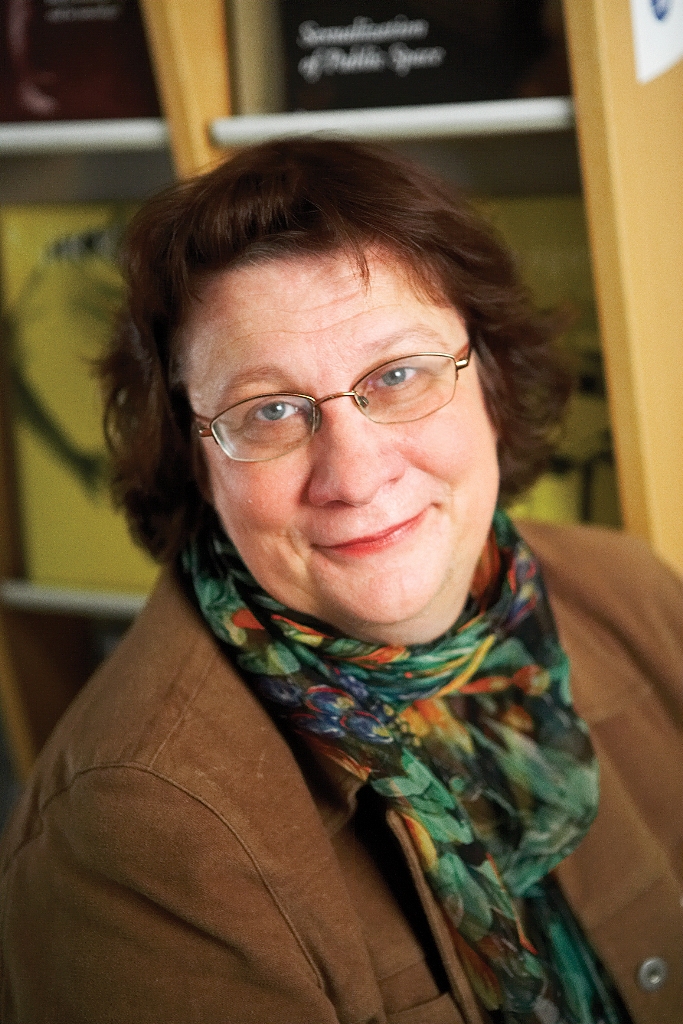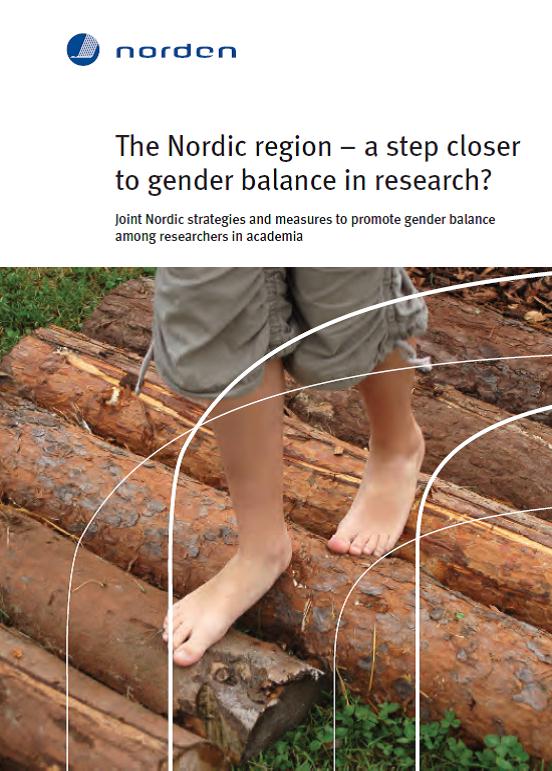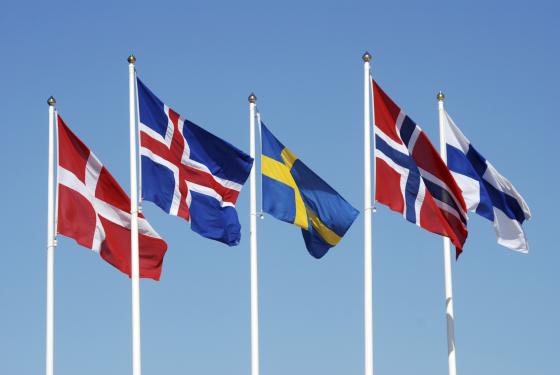The Nordic region – a gender equality paradise?
Although the Nordic countries have been good about bringing more women into academic leadership positions, they are only at the EU level when it comes to the percentage of female professors.
Are there joint Nordic strategies and measures for improving the gender balance in academia? And are the Nordic countries a step closer to gender balance in research? These are a few of the questions Solveig Bergman sought to answer in the report she wrote on commission from the Committee for Gender Balance in Research (the KIF Committee).
“The Nordic region excels in one area only – that is, the leadership of the national research councils and the institutional leadership in academia. And this is mainly due to quota provisions!”
“The Nordic countries have more women rectors and more women on the boards of the national research councils compared with other European countries,” says Bergman, who is a researcher at the Norwegian Centre for Violence and Traumatic Stress Studies.
“The provisions on gender quotas for government-appointed bodies have been instrumental in increasing female representation on the boards of the Nordic research councils. The rules requiring 40 percent representation of each gender have been crucial,” she notes.
Iceland, Finland and Norway require that at least 40 percent of both genders are represented in public committees and commissions. In practice, the same principle is followed in Sweden, while Denmark requires balanced gender composition but does not specify a percentage distribution.
Both research and politics
The new report The Nordic region – a step closer to gender balance in research? compiles what we know about legislation, research, statistics and measures, and it makes recommendations as well. The target groups are both the research sector and the gender equality sector.
“The topic of gender balance in academia often falls between two stools – research and gender equality. For us it’s important that politicians and bureaucrats from both sectors are the report’s main target groups,” Bergman emphasizes.
She hopes the report will result in more cooperation at the Nordic level.
“This is a long-awaited report. There is a need for Nordic cooperation and gender equality measures at the Nordic level, as well as at the European and international levels. Plus, Nordic cooperation can give a boost to the Nordic countries that lag behind the others,” she explains.
Scandinavian variation
The report shows that Norway and Sweden are unique; they are clearly the best in implementing gender equality measures in academia.
“But although Norway and Sweden have done the most with special measures to improve the gender balance, Finland is the country in the Nordic region with the most women in higher research positions,” says Bergman.
“Also, in a historic perspective Norway and Sweden have had a more positive attitude towards quotas and other women-specific measures than Finland. Despite this, Finland has long had the highest percentage of women professors in the Nordic region.”

Denmark has also had more faith in attitudinal change and less acceptance of specific initiatives. The situation for professors in Denmark is very imbalanced, with 85 percent men and 15 percent women.
“By the same token, I’m pleasantly surprised by Denmark. They have more good measures than you would think, both nationally and at the educational institutions.”
Iceland and Finland are best in the class
Recent figures show that Iceland, along with Finland, is now the Nordic country with the highest percentage of women professors in the Nordic region.
“Despite the small numbers that tend to inflate percentages, the trend on Iceland is interesting nonetheless,” says Bergman.
To gain a broader picture, it is also important to look at various recruitment patterns in the different countries, according to Bergman. For instance, the total number of professors varies widely and not all countries have a promotion system like Norway’s. In Norway there are two ways to become a professor, either by getting hired in a professor position or by being promoted to the professor level in a position the person already holds.
Three recommendations
The report shows that Nordic cooperation has a need for concrete development measures in three areas: policy development, research and statistics.
Recommendation 1:
The Nordic Council of Ministers will ensure that cooperation between the research and gender equality sectors in the field of gender balance in research in the Nordic region is launched in 2013.
Recommendation 2:
A Nordic research programme on gender balance in research will be established under the auspices of NordForsk and/or the Joint Committees for Nordic Research Councils with funding from the Nordic Council of Ministers and the Nordic countries.
Recommendation 3:
The Nordic Council of Ministers will launch a pilot project that systematically develops joint Nordic statistics on research and education in the field of gender balance in academia.
“The three recommendations must be viewed in relation to each other and all of them are crucial. However, the policy network (editor’s note: recommendation 1) could be launched quickly and is more fundamental to getting the others off the ground,” Bergman points out.
A challenge for Sweden
The 2013 presidency of the Nordic Council of Ministers is held by Sweden.
“It will be exciting to see what Sweden will do. A Nordic policy network under the Nordic Council of Ministers is perhaps the smartest start to the first recommendation in the report,” states Bergman.
A network like this is not expensive to establish and can serve as a platform for implementing the other measures, conducting research and compiling statistics.
Bergman also thinks it will be interesting to follow NordForsk. They finance Nordic research cooperation and give input on Nordic research policy. One of the points in their agreement with the European Commission from 2012 emphasizes a focus on issues related to gender equality and a gender perspective in research.
Not only numbers, but structures
The report also has a chapter on research policy reforms. Autonomy, excellence, internationalization and innovation are a few of the topics touched on in the report.
“Often reports on gender balance and gender equality in academia only discuss the quantitative distribution of positions, but we believe it’s important to look more at structural factors such as research policy reforms and new trends that are now making headway in academia,” Bergman continues.
Due to the new focus areas, gender equality efforts in academia have become more diverse and more complex. According to the report, incorporating a gender equality perspective when new areas are introduced, such as the excellence initiatives, innovation or internationalization, has proven to be a challenge. And although gender equality is a stated objective in academia in the Nordic countries, there are few comprehensive studies of university and research policy in a gender equality perspective.
EU better than the Nordic region
Compared with the pan-Nordic level, Bergman believes that the EU has a longer tradition of discussing structural factors and difficulties that impede gender equality in research – even though the individual Nordic countries have been talking about the issue for a long time.

“One of the main points in the report is that the joint Nordic research and gender equality policy under the Nordic Council of Ministers has not addressed these issues – something that the EU has done.”
“Take the centres of excellence, for example. These centres are given high priority within the EU and the Nordic region, but they have a lower percentage of women than in academia at large. Why is this?” Bergman asks.
The report refers to a survey of the Research Council of Norway’s Outstanding Young Investigators scheme (YFF), the Centres of Excellence scheme (SFF) and the Centres for Research-based Innovation scheme (SFI). The survey found that clarifying the expectations of the applicants and taking gender equality into account in the application process may have a positive impact on the gender distribution of the applicants and those selected to receive funding.
“However, raising awareness and clarifying expectations is only one answer. There is far too little research on excellence. Excellence policy entails many different things, such as how research activity is organized and which publication patterns are given priority. And all of this must also be studied in a gender and gender equality perspective,” says Bergman.
”This issue has not been discussed enough at the Nordic level, while the EU has worked with it since the report Gender and Excellence in the Making was released in 2004.”
Natural science as the ideal
Hierarchies in research is another topic that should be discussed in the Nordic region, according to Bergman.
“Are the natural sciences still idealized in the research sector? What happens then to the humanities and social sciences? If a centre in the social sciences or humanities is granted excellence status, does it have to resemble the MST subjects, such as language technology?” Bergman asks.
“Some reports conclude that the excellence initiatives have been a setback for gender equality, but we don’t have all the answers. More research is needed, both on national and Nordic research initiatives,” she states.
According to Bergman, it is important to remember that gender equality and gender balance deals not only with women and men, but also with subjects, academic hierarchies, scientific content and priorities.
“What happens with the interpretive humanities and social sciences in a research world with excellence initiatives where the natural sciences are held up as the ideal?” she asks.
Translated by Connie Stultz.
The Committee for Gender Balance in Research (the KIF Committee) commissioned the report The Nordic region – a step closer to gender balance in research? Joint Nordic strategies and measures to promote gender balance among researchers in academia. The report was written by Solveig Bergman with assistance from Linda M. Rustad of the KIF Committee and a Nordic reference group.
The Research Council of Norway and NordForsk assisted with the design of the project and contributed funding. Both the Nordic Council of Ministers for Education and Research and the Nordic Council of Ministers for Gender Equality have also allocated funding.
Key figures
The gender distribution of professors in the Nordic region in 2010:
- Finland: 24 percent women, 76 percent men
- Iceland: 24 percent women, 76 percent men
- Norway: 21 percent women, 79 percent men
- Sweden: 20 percent women, 80 percent men
- Denmark: 15 percent women, 85 percent men
The EU average is 20 percent female professors and 80 percent male professors.
Solveig Bergman has years of experience with Nordic cooperation, including as the former head of the Nordic Gender Institute (NIKK). Bergman is a researcher at the Norwegian Centre for Violence and Traumatic Stress Studies.

